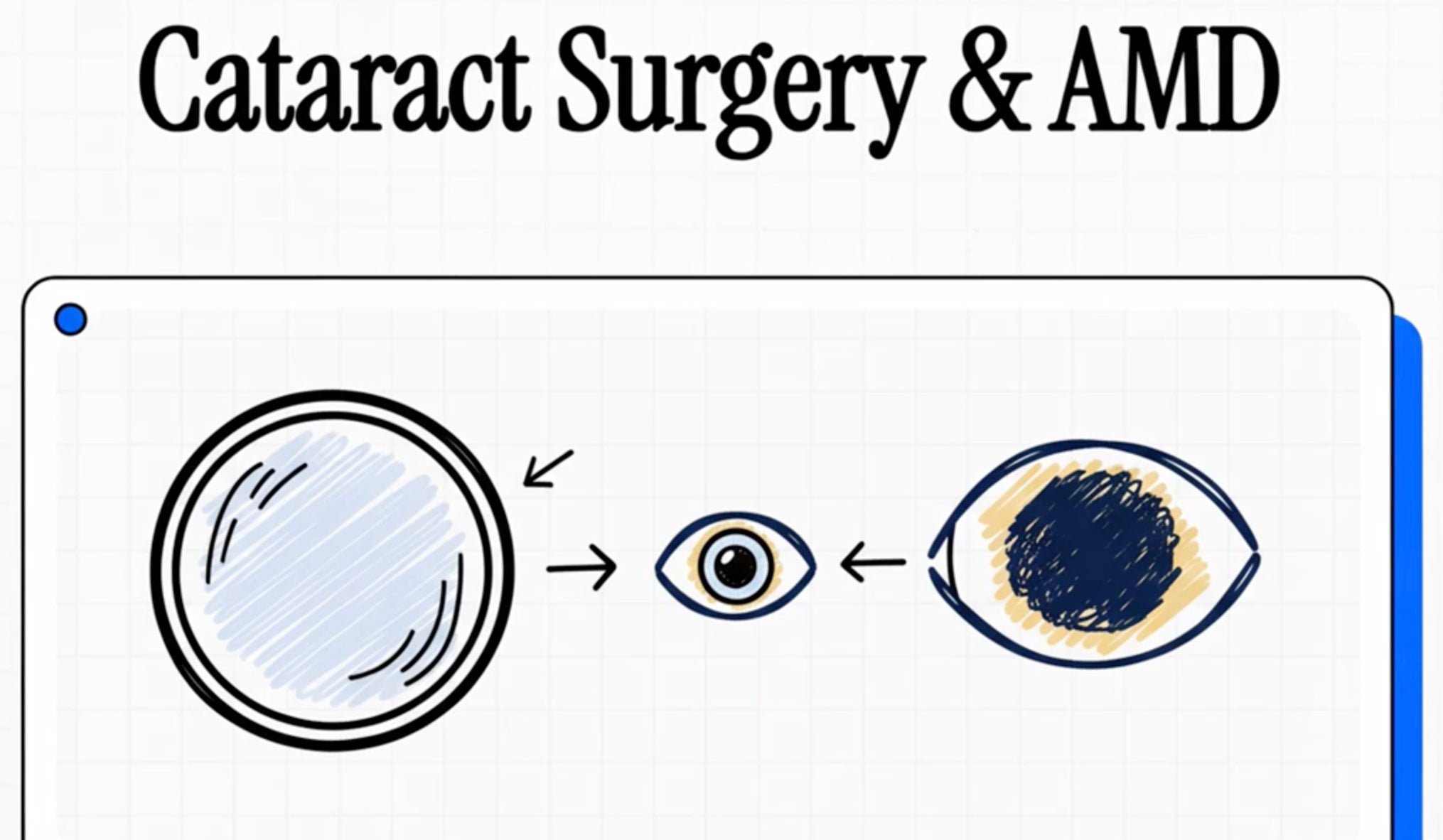Seeing the Heart Through the Eyes: The Link Between Age-Related Macular Degeneration and Cardiovascular Health
1. Understanding Age-Related Macular Degeneration (AMD)
Age-related macular degeneration (AMD) is the leading cause of severe, irreversible vision loss among adults aged 50 and older. It primarily affects the macula, the central part of the retina responsible for sharp, detailed vision used for reading, recognizing faces, and driving.
Globally, AMD affects approximately 170 million people, a number projected to reach 288 million by 2040. In the United States alone, it currently impacts over 11 million individuals, with this figure expected to double by 2050
AMD and CVD
.
Two Main Forms of AMD
-
Dry (atrophic) AMD: Represents about 80% of cases. It develops gradually as light-sensitive cells in the macula deteriorate, often accompanied by yellowish deposits called drusen.
-
Wet (neovascular) AMD: Though less common, this form is more severe and progresses rapidly due to the growth of abnormal, fragile blood vessels beneath the retina that leak fluid or blood.
Recent therapeutic advances—such as anti-VEGF injections for wet AMD and complement inhibitors for geographic atrophy—have slowed progression in many patients. However, no current treatment restores lost vision.
Increasingly, researchers view AMD as not just an ocular disease but a localized reflection of systemic vascular dysfunction. The retina’s rich microvascular network and high oxygen demand make it especially sensitive to the same oxidative and inflammatory processes that affect cardiovascular health.
2. Cardiovascular Disease (CVD): A Systemic Parallel
Cardiovascular disease (CVD) is a collective term for conditions affecting the heart and blood vessels, including coronary artery disease, stroke, hypertension, heart failure, and peripheral artery disease.
It remains the leading global cause of death, responsible for roughly one-third of all mortalities worldwide. Most forms of CVD stem from atherosclerosis, the accumulation of fatty plaque that narrows arteries and disrupts blood flow.
Importantly, many of the modifiable risk factors for CVD — such as smoking, high cholesterol, high blood pressure, diabetes, and physical inactivity — are also recognized contributors to AMD. This overlap reinforces that both conditions share not just risk factors but common biological pathways
AMD and CVD
.
3. Shared Risk Factors: The “Common Soil” Hypothesis
AMD and CVD often arise from the same underlying physiological vulnerabilities — sometimes described as the “common soil” of systemic inflammation, oxidative stress, and vascular damage.
Key shared risk factors include:
| Category | Risk Factor | Impact on AMD | Impact on CVD |
|---|---|---|---|
| Modifiable | Smoking | Increases both dry and wet AMD risk | Major cause of atherosclerosis and heart disease |
| Hypertension | Damages ocular microvasculature | Leading cause of stroke and heart failure | |
| High Cholesterol | Lipid-rich drusen formation | Promotes plaque buildup in arteries | |
| Obesity / Poor Diet | Raises oxidative stress and inflammation | Contributes to diabetes and hypertension | |
| Diabetes | Damages retinal and vascular endothelium | Major cause of heart, kidney, and vascular disease | |
| Physical Inactivity | Linked to AMD progression | Increases risk of cardiovascular events | |
| Non-Modifiable | Age | Principal risk factor for both | Principal risk factor for both |
| Genetics / Family History | CFH and APOE gene variants | APOE and lipid-metabolism gene variants | |
| Race / Ethnicity | More prevalent in White populations | Disproportionate burden in several racial/ethnic groups |
This overlapping profile highlights that supporting cardiovascular health inherently supports ocular health.
4. Biological Pathways Connecting AMD and CVD
Chronic Inflammation
Persistent low-grade inflammation is a core driver of both diseases. Elevated C-reactive protein (CRP) levels predict cardiovascular events and are also found in AMD patients.
In AMD, activation of the complement system—a component of innate immunity—contributes to drusen formation, paralleling vascular inflammation seen in atherosclerosis
AMD and CVD
.
Oxidative Stress
Both AMD and CVD involve oxidative damage caused by an imbalance between reactive oxygen species (ROS) and antioxidant defenses. The retina’s high metabolic rate makes it particularly susceptible, while oxidative stress also injures blood vessels throughout the cardiovascular system.
Vascular Dysfunction
Endothelial dysfunction — impaired ability of blood vessels to regulate flow — is a shared early feature.
Strikingly, the lipid-rich drusen of AMD and atherosclerotic plaques of CVD share similar components, including lipids, proteins, and calcium, reinforcing the idea that AMD reflects localized atherosclerotic-like processes in the eye.
5. Cardiovascular Health as a Foundation for Vision Protection
Because AMD mirrors systemic vascular and metabolic disturbances, strategies that preserve cardiovascular health can also protect vision.
A major reference in this field, the American Heart Association (AHA) Presidential Advisory (Lloyd-Jones et al., 2022), proposed an updated model for cardiovascular health assessment known as Life’s Essential 8
lloyd-jones-et-al-2022-life-s-e…
lloyd-jones-et-al-2022-life-s-e…
.
While developed for heart health, this framework is highly relevant to AMD prevention and overall aging wellness.
The AHA identifies eight key components for maintaining optimal cardiovascular health — all of which overlap with modifiable risk factors for AMD.
6. The Eight Pillars of Cardiovascular Health
(Adapted from Lloyd-Jones et al., Circulation, 2022)
-
Healthy Diet:
Prioritize Mediterranean- or DASH-style eating — abundant in fruits, vegetables, whole grains, legumes, and fish — to reduce oxidative and inflammatory stress on both the heart and retina. -
Physical Activity:
Engage in at least 150 minutes of moderate-to-vigorous activity per week to improve circulation, blood pressure, and lipid balance. -
Nicotine Avoidance:
Eliminate smoking and exposure to second-hand smoke — a potent driver of both AMD and CVD. -
Healthy Sleep:
Aim for 7–9 hours of quality sleep nightly. Consistent sleep patterns are linked to better blood pressure control and reduced systemic inflammation. -
Healthy Weight:
Maintain a BMI below 25 kg/m². Healthy weight supports vascular function and lowers oxidative load. -
Blood Lipids:
Keep non-HDL cholesterol below 130 mg/dL to reduce atherosclerotic and drusen formation. -
Blood Glucose:
Maintain normal fasting glucose (<100 mg/dL) or HbA1c (<5.7%) to prevent microvascular damage in both the retina and cardiovascular tissues. -
Blood Pressure:
Strive for <120/80 mm Hg, as even mild hypertension accelerates both retinal and systemic vascular damage.
These pillars represent a science-backed roadmap for improving cardiovascular function — and by extension, retinal health — across the lifespan.
7. The Broader Context: Mental and Social Well-being
The AHA report also highlights that cardiovascular health depends on more than biological factors. Psychological well-being and social determinants of health — such as education, income, neighborhood environment, and community support — are critical influences on one’s ability to maintain healthy behaviors
lloyd-jones-et-al-2022-life-s-e…
.
Optimism, stress resilience, and access to supportive environments foster adherence to healthy lifestyles, which in turn benefit both the heart and the eyes.
8. Integrating the Evidence: Heart Health Equals Vision Health
AMD and CVD share a biological foundation rooted in inflammation, oxidative stress, and vascular compromise.
The evidence reviewed here — including the American Heart Association’s Life’s Essential 8 framework — underscores that the same habits that protect the heart can also protect the eyes.
Practical Takeaway:
-
Eat antioxidant-rich, whole foods.
-
Exercise regularly.
-
Quit smoking.
-
Sleep adequately.
-
Maintain optimal blood pressure, glucose, and cholesterol levels.
These simple but powerful steps enhance longevity, cognitive health, and quality of life, while also helping preserve the precious gift of sight.
References
-
Lloyd-Jones DM, Allen NB, Anderson CAM, et al. Life’s Essential 8: Updating and Enhancing the American Heart Association’s Construct of Cardiovascular Health. Circulation. 2022;146:e18–e43
lloyd-jones-et-al-2022-life-s-e…
.
-
The Intertwined Relationship Between Age-Related Macular Degeneration and Cardiovascular Health. Internal Review Blog post at Persavita.ca, 2025
AMD and CVD
.


Leave a comment
This site is protected by hCaptcha and the hCaptcha Privacy Policy and Terms of Service apply.